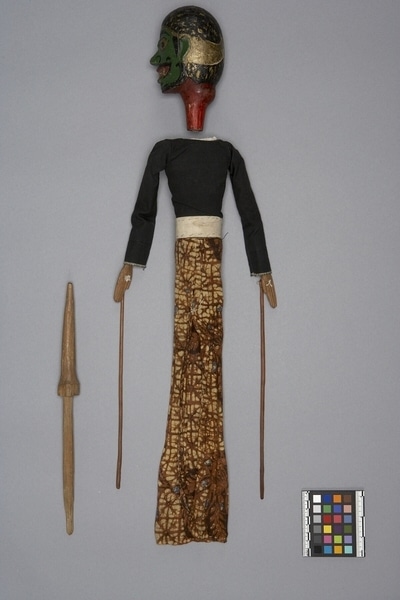Rod Puppet Item Number: Ib311 from the MOA: University of British Columbia


Description
Three-dimensional male humanoid puppet: large head (part b) fits into body with skirt (part a), and a control rod (part c) with a long shaft passes through the body and fits into the neck of the figure's head. The body has jointed arms, each with a long controlling rod attached. Figure has a dark green face, and a painted black cap with gold trim and gold flecks. The figure also has black eyebrows, moustache, and beard. Large gold eyeballs with red irises and black pupils. Two rows of gold teeth surrounded by red lips with small fangs on each side of the mouth. Red neck. Unpainted torso clothed in black, tight fitting shirt with pink circles on cloth on right and left sides of puppet, and blue circle on pink on left. Band of white at neck and cuffs, band of green down centre right with zigzag of gold. Beige band at waist, long skirt slit at back of brown, off-white, and blue batik pattern. Arms attached by string to torso, with joints at elbow connected by string.
History Of Use
Javanese puppetry as an art form probably developed by the 11th century. The three-dimensional wooden wayang golek puppets of western Java, which are to be distinguished from the earlier and more sacred wayang kulit shadow plays puppets or other forms, appeared during the 16th century. Originally the plays depicted Javanese mythology, but after the Indian conquest of Java the Hindu epics, Ramayana and Mahabharata, were incorporated into the cycles, which comprise about 200 plays. An individual or group hires a dalang (puppet-master) to celebrate important occasions. The performances often last all night and are generally presented in three acts, with vocal and instrumental accompaniment. The individual plays vary widely in detail but usually involve conflict between good and evil. They serve a moral and religious purpose, and more recently, one of political commentary. Each puppet's character is represented by its appearance and placement onstage; protagonists with strong elements of good are placed to the right, antagonists of violent or evil nature to the left. This puppet may have variable roles in the wayang, defined by the dalang but limited by its features. It may play the part of a minor prince or administrator, but not, as denoted by its wealthy clothes, a servant or commoner.
Cultural Context
Theatrical performance.
Iconographic Meaning
Large eyes with red irises, bulbous nose, fangs are negative characteristics associated with arrogance or evil. Symbolism of green skin not known. Tight fitting shirt and batiked skirt are indicative of persons of wealth or nobility. Character unidentified; perhaps plays variable roles defined by the dalang.
Item History
- Made in Java, Indonesia
- Owned by Tradewind Antiques before March 15, 1983
- Received from Museum of Anthropology Shop Volunteers (Funding source) and Tradewind Antiques (Seller) on March 15, 1983
What
- Name
- Rod Puppet
- Identification Number
- Ib311
- Type of Item
- puppet
- Material
- wood, cotton fibre and paint
- Manufacturing Technique
- carved, machine woven, painted and sewn
- Part A
- height 50.0 cm, width 11.0 cm, depth 6.0 cm
- Part B
- height 15.0 cm, width 7.5 cm, depth 9.5 cm
- Part C
- height 32.2 cm, diameter 2.5 cm
Who
- Culture
- Sundanese
- Previous Owner
- Tradewind Antiques
- Received from
- Museum of Anthropology Shop Volunteers (Funding source) and Tradewind Antiques (Seller)
Where
- Holding Institution
- MOA: University of British Columbia
- Made in
- Java, Indonesia
When
- Ownership Date
- before March 15, 1983
- Acquisition Date
- on March 15, 1983
Other
- Condition
- fair
- Accession Number
- 0886/0045